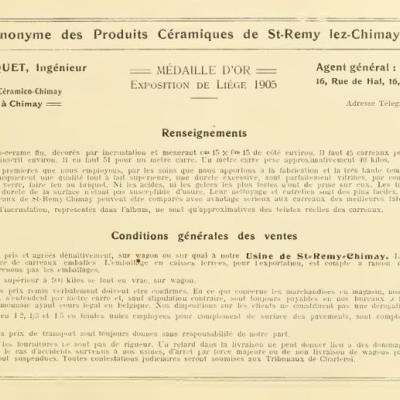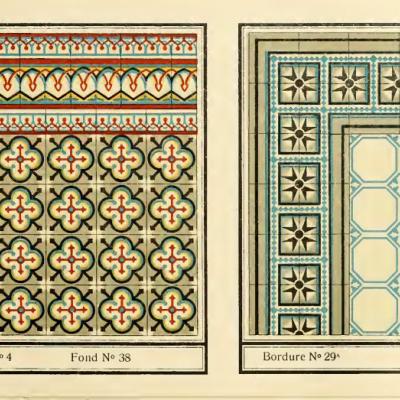A large Chimay ceramic with triple borders - c.33.25m2 / 360 sq ft.
A large antique Belgian ceramic encaustic floor, complete with its same size and half size border tiles, dating from the early part of the 20th century. The floor totals c.33.25m2+ / 360 sq ft in surface area and consists of a principal 15cm sq field tile, a same size border and a half size border, which is laid in duplicate framing the main. All of the large border corner tiles and half size border corner tiles have been reclaimed. At 15mm thick the tiles are an excellent ceramic.
The main field tiles offer a classically geometric tessellation in a cool palette, framed by a more fluid border. Reverse stamped CPRS they were handmade by Societe Anonyme Produits Ceramiques St Remy-Chimay, a heritage Belgian ceramic producer established close to the Belgian city of Chimay. A photograph of the tile factory, now long since closed, is shown in the gallery as is a scan from the 1905 St Remy Catalogue in our possession showing the tile spread.
The floor, cleaned of its mortar to the back and sides and with the faces having had their old wax and dirt removed, now displays its rich and warm antique patina; edge nibbles and small chips, all groutable, are evident as can be seen in a small number of tiles in the high resolution photographs. Owing to the labour intensive handmade production method of making the tiles in two tile moulds there is some tonal variation in the colour of the tiles, most notably in the burgundy on the border tiles.
Being a highly fired tile it can be laid inside or outside of the home as the ceramic is resistant to high summer and sub zero temperatures.
Tile quantities by tile type:-
FIELD - 1,010 tiles - 22.75m2 / 245 sq ft.
LARGE BORDERS - 230 tiles plus 4 corners - 5.3m2 / 56.7 sq ft. - 35.1 linear metres / 115.2 linear feet
SMALL BORDERS - 460 tiles plus 8 corners - 5.3m2 / 56.7 sq ft. - 70.2 linear metres / 230.4 linear feet
NOTE
Antique tiles were most commonly made in single or two tile moulds. Before current computer automation methods their moulds were made by hand and the colour slips mixed by eye. Kiln temperatures could also be variable, as could the firing time. The result is that often tiles display subtle size and thickness variations and there can be tonal variations in colours, owing to the slip mixing and/or firing time. All of this makes these handmade tiles unique and adds to their charm. Some floors display their subtle variations in size and tones, some not, but when photographing we always take a random section of the floor so that it is representative of the whole. A tiler should always dry lay a section of the tiles to familiarise himself with them before starting to fix lay.
CL130 CL160 MAD63







